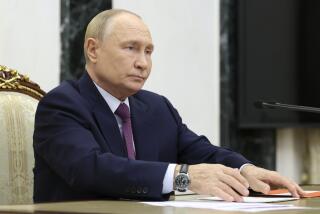Pentagon Maps Post-Cold War Defense Plans
- Share via
WASHINGTON — A secret Pentagon planning document orders the U.S. military services to prepare for a time when the United States could fight major wars in two regions of the world at once and thwart adversaries equipped with formidable, high-technology weapons.
The classified Defense Guidance document, drafted to steer Pentagon budgeting and U.S. military strategies, was signed by Defense Secretary Dick Cheney on Friday. A copy of a draft obtained by The Times describes a future in which democratic successors to the Soviet Union--especially Russia and Ukraine--may become “strategic partners” with the United States in the years ahead.
The plan is intended to shape U.S. defense spending priorities in fiscal years 1994 to 1999.
The document shows that the Pentagon now sees the greatest prospect for danger in the proliferation of increasingly destructive weapons throughout the Third World, including radar-evading cruise missiles, submarines, satellites and nuclear- and chemical-weapons complexes buried in deep underground bunkers.
It says that U.S. Stealth bombers, sophisticated sensors and precision weapons will remain key to allied victories against even Third World threats. “If the use of weapons of mass destruction is threatened, we may need to win even more quickly and decisively,” the document says.
Such rapid victories appear to be especially important in a future of constrained defense budgets, according to the plan.
The draft departs from a controversial earlier version by stressing the importance of multinational responses to regional crises. At the same time, however, it clearly casts the United States as the nation whose leadership, national will and military strength will be the driving force behind multinational alliances.
“Our preference for a collective response to preclude threats or, if necessary, to deal with them is a key feature of our regional defense strategy,” the document says.
Pentagon officials said that the United States’ ability to act alone, “should international support prove sluggish or inadequate,” remains the cornerstone of U.S. military planning. But the document stresses that the nation’s ability to act alone is important because it is the only way to rally international coalitions and to “encourage others to resist aggression,” as the United States did in the Persian Gulf War.
One Bush Administration official acknowledged that an earlier draft of the Defense Guidance, which was widely quoted in news accounts, appeared overly “preoccupied” with the prospect of unilateral U.S. action.
In preparing the final draft, officials said they sought to curb earlier language that suggested the United States should stand alone in its superpower status and resist the emergence of competitors on the world scene. One government official cautioned that “there should be at most one superpower” but added that the United States should not discourage prospective partners by appearing bent on dominating the world.
One Bush Administration official called the new Defense Guidance paper “a decisive break from Cold War thinking.” At the same time, the official warned that the document “is not apologetic about the contributions that America can make” in shaping the course of world events.
Indeed, the guidance paper appears to stress maintaining military strength not as an end in itself but as a means by which to mold world developments in ways that suit U.S. interests. Officials said the paper reflects Cheney’s conviction that only by maintaining a “base force” of more than a million men and women under arms can the United States keep the peace and avoid paying more dearly later to thwart emerging threats.
In a surprising group of passages, however, the document notes that the United States may now become more selective in its decisions to commit troops to crises abroad.
“The United States remains a nation with global interests, but we must re-examine in light of the new defense strategy whether and to what extent particular challenges engage our interests,” the document says. With the end of “Cold War bipolarity” that drove the United States to treat--and counter--each move in the Third World as a Soviet bid for dominance, America may wish to sit out some regional conflicts, the document notes.
At the same time, however, it notes that potentially hostile powers like North Korea and Iran could both blow up simultaneously, requiring U.S. troops to conduct operations in two major areas of the world at the same time.
While the United States is engaged in one substantial regional crisis, it says, “potential aggressors in other areas may be tempted to exploit our preoccupation.” That, it notes, could require U.S. troops to scramble to a second “major regional crisis” on short notice.
More to Read
Sign up for Essential California
The most important California stories and recommendations in your inbox every morning.
You may occasionally receive promotional content from the Los Angeles Times.














